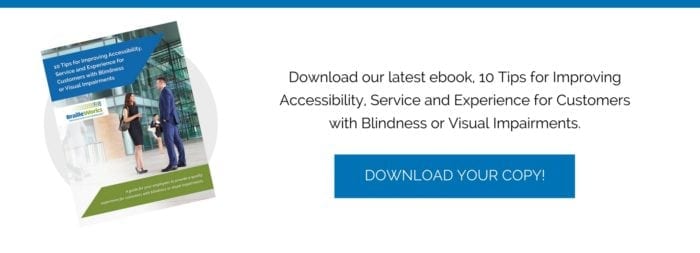5 Accessibility Tips Every Company Should Implement
Published on
Can your customers with visual disabilities find the information they need to make a buying decision quickly and easily? Are your employees trained on how to serve these customers best? Do you need accessibility tips to be more inclusive?
Addressing the needs of your customers with disabilities helps your business. For example, happy customers share positive reviews online and refer their friends and family to your company. Being accessible may also save your business from costly fines if a customer files a discrimination lawsuit.
If accessibility isn’t a part of your business strategy, you’re excluding one billion people worldwide. You’re also leaving money on the table.
It’s good business–and the law–to make your company friendly and accommodating to people with disabilities. So here are a few accessibility tips you should incorporate.
1. Clear a path.
This can be both literal and figurative.
If your business has a physical location, free your floor of all obstacles. Removing physical obstructions eliminates hazards. In addition, this allows customers with canes, wheelchairs, or guide dogs the ability to move through the area freely. When people can move freely, they’re more likely to have an enjoyable experience.
Accessibility applies even if you don’t have a physical location. Your public-facing website and all online materials must also be accessible. When discussing written or digital communications, consider the Americans with Disabilities Act (ADA) and the Rehabilitation Act, particularly Section 508. This legislation prohibits discrimination against individuals with disabilities and provides guidance on making your web content accessible. In fact, the Department of Justice recently released guidance on this very subject.
The quicker someone can gather information or buy products on your site, the more likely they will return.

2. Provide accessible materials.
Are you planning on designing a new flyer, website, menu, or document? Each new print material should be reviewed for compliance and have an alternative format.
For example, powerful, attention-grabbing graphics and aesthetics may make it difficult for people with visual impairments to access the information they need. So instead, place important text away from the images and use alternate text to describe the image.
Offer alternative formats like braille, large print, and accessible PDF documents. These help people with visual and cognitive disabilities engage with your business. Accessible formats are helpful for people with various disabilities, such as dyslexia and low vision. However, all disabilities are not the same. An accessible document format that one person prefers may not be accessible to the next. Provide a variety of accessible formats from which your customers can choose.
3. Ask more questions.
Laws like the ADA and Sections 508 and 504 of the Rehabilitation Act can be confusing. Document accessibility partners are great resources for all your accessibility questions. Each new communication project should be reviewed for compliance and have alternative format options.
An accessibility partner can also provide feedback about the customer experience and marketing ideas to maximize the investment in ADA-compliant materials.
4. Train your employees to be accessibility evangelists.
Educate your employees and train your staff to promote accessibility. For example, offer training on how to assist with assistive technology and mobility devices. It’s also essential to provide guidance on interacting with service animals.
Your team makes a difference when they’re informed. Likewise, identifying barriers helps customers feel welcomed.
5. Start a movement in your company!
Organizations that adopt accessibility as part of their in-house initiatives make a difference. If your company isn’t currently addressing accessibility issues, you can help them become more accessible for people with disabilities. When accessibility is at the forefront, businesses are committed to inclusivity.
Build a company strategy that promotes accessibility and inclusion in-house. Then, announce your commitment to accessibility, making it a recognizable part of your business.
See the opportunity, not the task.
These accessibility tips are an opportunity, not a chore. Look for ways to transform documents and include customers with disabilities. What does this mean for your business? Accessibility sets you apart as a leader in your industry and advocates for all customers.

Categorized in: Accessibility, Uncategorized
This post was written by



Comments are closed here.